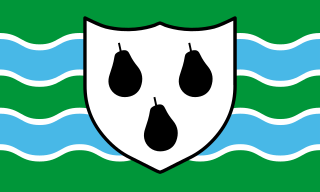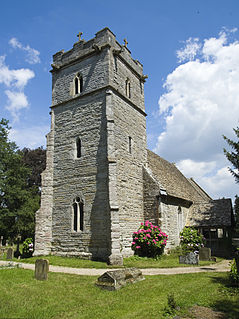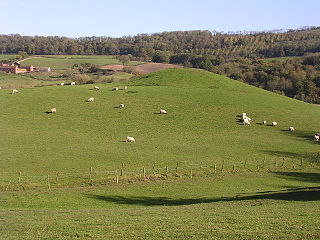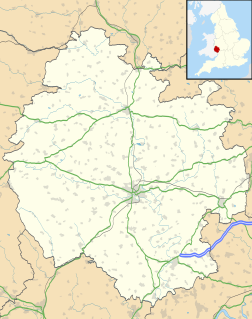
Abberley is a village and civil parish in north west Worcestershire, England.

Leigh is a village and civil parish in the Malvern Hills district of the county of Worcestershire, England.
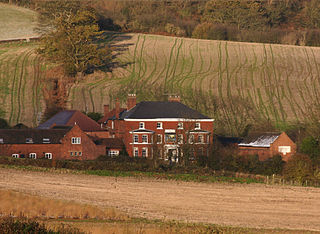
Great Witley is a village and civil parish, in the Malvern Hills District in the northwest of the county of Worcestershire, England. It is situated around ten miles to the north west of the city of Worcester.

Martley is a village and civil parish in the Malvern Hills district of the English county of Worcestershire. It is approximately nine miles north-west of Worcester. The population of the village is approximately 1,200 people. The mixed farming of the area includes arable, formerly cherry, apple, damson orchards and hopyards.
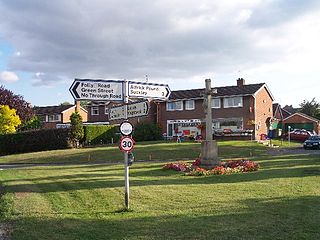
Alfrick is a village and civil parish in the Malvern Hills district of Worcestershire, England, about seven miles west of Worcester.

Stockton on Teme is a village and civil parish in the Malvern Hills District in the county of Worcestershire, England. It is close to the River Teme and is noted for its 12th century Norman church with an unusual circular graveyard.(photo).

Broadwas or Broadwas-on-Teme, is a village and civil parish in the Malvern Hills district of Worcestershire, England. According to the 2001 census it had a population of 307. The village is located on the River Teme, about 6 miles west of Worcester on the A44 road.

Cotheridge is a village and civil parish in the district of Malvern Hills in the county of Worcestershire, England. It is 4 miles (6 km) west of the city of Worcester and a mile north-east of the Leigh Court railway station on the Great Western Railway on the opposite side of the River Teme.
The River Teme flows on the southern and south-western part of the village where the land is low-lying and is susceptible to flooding. The soil content is loam and clay with the subsoil being Keuper Marl.

Grimley is a village and civil parish in the Malvern Hills District in the county of Worcestershire, England about 3 miles (4.8 km) north of Worcester.

Bransford is a village and civil parish in the Malvern Hills district of the county of Worcestershire, England. It is situated close to the River Teme and the village of Leigh. It is on the primary route between Worcester and Hereford, the A4103 that runs through the centre of the village. According to the 2011 census, Bransford has a population of 389. The parish shares its parish council with Leigh.

Knightwick is a small village and civil parish in the Malvern Hills district in the county of Worcestershire, England.

Pensax is a village and civil parish of northwest Worcestershire in England, incorporating the hamlet of Menithwood to the west of Pensax Common. According to the 2001 census, the parish had a population of 317.
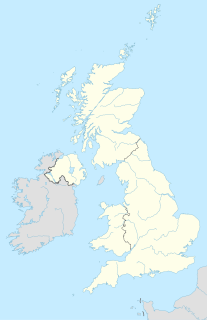
The Shelsleys are a group of small villages in the Malvern Hills District in the county of Worcestershire, England. The Shelsleys are near the village of Clifton-upon-Teme the Teme Vally, and they encompass the three very distinct hamlets and civil parishes Shelsley Beauchamp, Shelsley Kings and Shelsley Walsh. The three parishes share a parish council.
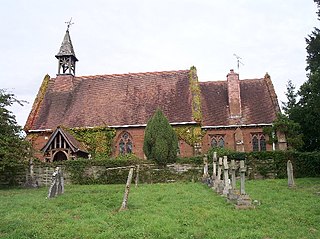
Lulsley is a village and civil parish in the Malvern Hills District of the county of Worcestershire, England, UK.
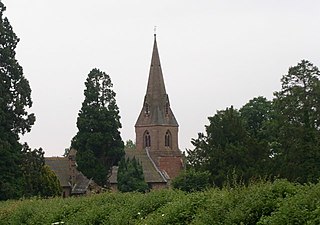
Wichenford is a village and civil parish in the Malvern Hills District in the county of Worcestershire, England. It lies 6 miles to the north-west of the city of Worcester.

Shrawley is a village and civil parish in the Malvern Hills District in the county of Worcestershire, England. The village is situated on the western bank of the River Severn. The northern and southern boundaries of the parish are two small tributaries of the River Severn, Dick Brook to the north and Shrawley Brook to the south. To the west is Hillhampton, the north west and north is the parish of Astley and to the south Holt.

Stanford-on-Teme is a village and, with the village of Orleton just under a mile away, is also a civil parish in the Malvern Hills District in the county of Worcestershire, England.
The Hundred of Doddingtree was granted to Ralph Todeni, or Ralph de Toni, a relative of the Duke of Normandy, in 1066 by William the Conqueror as a reward for his services as Standard bearer during the Norman Conquest. It consisted mainly of west Worcestershire.
Following the Poor Law Amendment Act 1834 individual parishes ceased to be responsible for maintaining the poor in their parish. Poor law unions were established. In west Worcestershire the Martley Poor Law Union was established to take the poor from the following parishes Abberley, Alfrick, Astley, Bransford, Broadwas, Clifton-upon-Teme, Cotheridge, Doddenham, Great Witley, Grimley, Hallow, Holt, Knightwick, Leigh, Little Witley, Lulsley, Martley, Pensax, Shelsley, Shrawley, Suckley and Wichenford.


